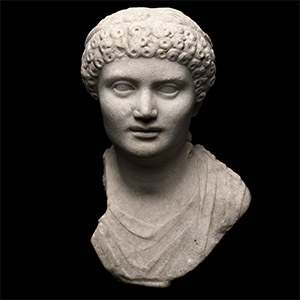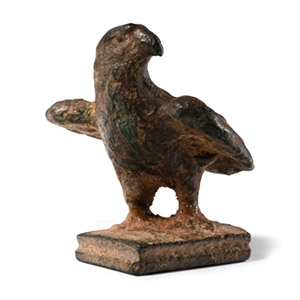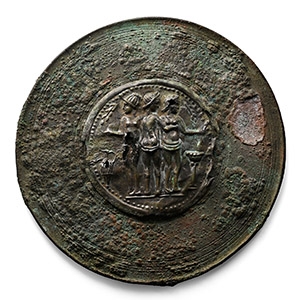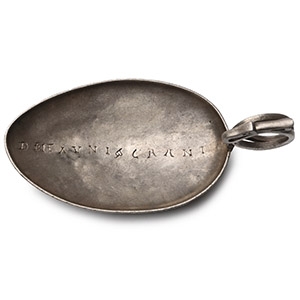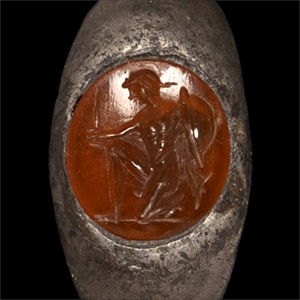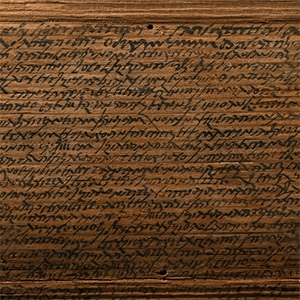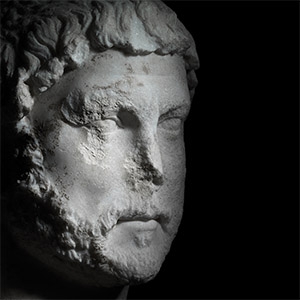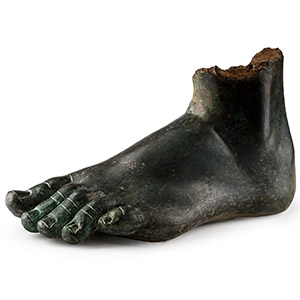Home > Auctions > 9 - 17 September 2025
Ancient Art, Antiquities, Books, Natural History & Coins
Acquired from a private UK collection prior to 1979.
Ex Julian Sherrier collection, a leading figure in Gandharan art.
Ex Christie's, New York, 14th September 2010, no.40 (part).
This lot is accompanied by an illustrated lot declaration signed by the Head of the Antiquities Department, Dr Raffaele D'Amato.
Cf. Barratte, F., East and West, A Central Asia Silver hoard from the Parthian East, 2002, p.39, fig.19.
Professor Elia Volpi (1858-1938) collection, Florence, prior to 1910.
Vente de la Collection Elie Volpi; Hotel de Ventes Jandolo & Tavazzi, Florence, 25 April-3 May 1910, no.53, pl. XCII (illustrated).
Private collection, France, likely Château de Beaumesnil, near Rouen.
Provenant du Château de Beaumesnil et du Château de T...Objets d'Art et de Bel Ameublement Principalement du XVIIIe, Palais des Congres, Rouen, 20 February 1983.
Anonymous sale; Hindman, Chicago, 25 May 2023, no,194.
Acquired by the present owner at the above sale.
Accompanied by an academic report by Dr Raffaele D'Amato.
This lot has been checked against the Interpol Database of stolen works of art and is accompanied by search certificate number no.12768-237645.
This lot has been cleared against the Art Loss Register database, and is accompanied by an illustrated lot declaration signed by the Head of the Antiquities Department, Dr Raffaele D'Amato.
See similarity with portraits of Agrippina the Younger, in Uffizi (Firenze) in modern bust, inventory 1914 n.115; NY Carlsberg Glyptotek, Copenhagen, inv. no.753 in Johansen, F., Catalog of Roman Portraits I, Copenhagen, 1994; see also the portraits of Agrippina in MANN (Napoli) inv.5609 and 5612, from Herculaneum; other similar portraits in Rhode Island School of Design (RISD) museum, inv.56.097; Palatine Hill (Antiquarium of Palatine Hill), Rome, inv. no.12447; compare the hairstyle and the profile with the British Museum sardonyx cameos (GB 1872.6-4.1992, gem 3951) representing the same empress.
Various, Illustrations du Catalogue des Précieuses Collections d'Objets d'Art Appartenant au Prof. Elie Volpi (Exhibition Catalogue), Florence, 1910, no.53; Various, La Gazette de L'Hôtel Drouot, edition 5 (Gazette), Paris, 4 February 1983, p.36; Freyer-Schauenburg, B., ‘Porträtbüste einer Dame in Schweizer Privatbesitz’ in Varkıvanç, B. (ed), Baki Öğün'e Armağan - Melanges offerts a Baki Öğün - CALBIS, Ankara, 2007, pp.97-108.
This portrait is striking due to the delicate yet exotic features of the subject and her elaborate coiffure. The sculpture was produced during a formative and highly sophisticated phase of Roman art, and during a time when portraits of women are much less common than those from later Imperial times. The preparation for a patch at the back of the head is seemingly ancient. Although she remains anonymous, given the sculpture's scale and scope, one can assume it portrays a person of note, who wished to be represented with the ideal and distinctive features of a Roman aristocrat. For a comparable portrait bust, see Agrippina Minor at the NY Carlsberg Glyptotek, Copenhagen (Acc. no.755).
Acquired in the mid 1980s-1990s.
Private collection, Switzerland, thence by descent.
Private collection, since the late 1990s.
This lot has been checked against the Interpol Database of stolen works of art and is accompanied by search certificate number no.12239-222315.
This lot has been cleared against the Art Loss Register database, and is accompanied by an illustrated lot declaration signed by the Head of the Antiquities Department, Dr Raffaele D’Amato.
This lot is accompanied by an illustrated lot declaration signed by the Head of the Antiquities Department, Dr Raffaele D'Amato.
Cf. Rolland, H., Bronzes Antiques de Haute Provence, Paris, 1965, item 268.
with Sotheby's, New York, 7 December 1973, no.78.
Private collection, London.
Accompanied by copies of the relevant Sotheby's catalogue pages.
Accompanied by an academic report by Dr Raffaele D’Amato.
This lot has been checked against the Interpol Database of stolen works of art and is accompanied by search certificate number no.12819-241350.
This lot has been cleared against the Art Loss Register database, and is accompanied by an illustrated lot declaration signed by the Head of the Antiquities Department, Dr Raffaele D'Amato.
See Reinach, S., Repertoire de la statuarie grecque et romaine, Paris, 1930, p.342 no.7, for a similar statuette.
The Venus Anadyomene shows the birth of the Goddess of Love, conceived in the womb of the sea after the Titan Chronos castrated his father, Uranus, and cast his genitals into the water. Venus was born from the sea, fully grown. In ancient tradition, Aphrodite had her great sanctuary at Paphos, because it was here that she was thought to have risen from the water. Apelles, the great painter, was said to have painted the original, creating the prototype then imitated in paintings, sculptures, and across Graeco-Roman iconography. However, his work is now lost, and from the late 2nd century/early first century B.C. until the late antique period, the Anadyomene appeared in nearly every format imaginable. Like many other naked Aphrodites, the Anadyomene was not posed to conceal the body, but was naked and unashamed, exposing the goddess’ body to the gaze of the viewer.
Ex German art market, 2000s.
Acquired from an EU collector living in London.
From the collection of a Surrey, UK, gentleman.
This lot is accompanied by an illustrated lot declaration signed by the Head of the Antiquities Department, Dr Raffaele D'Amato.
UK private collection, 1990s.
with Artemission, London, UK.
Private collection, London, UK.
This lot is accompanied by an illustrated lot declaration signed by the Head of the Antiquities Department, Dr Raffaele D'Amato.
Cf. The British Museum, 1981,0201.54 and 1981,0201.58; for inscription 1981,0201.74.
Professor Dr phil. Peter Rothenhöfer writes: 'In RIB the inscription is categorized as 'religious dedication'; this must be rejected as we would expect the Dative case: deo Fauno ... - for the god Faunus ... But we read the genitive case: dei Fauni Crani: (property of) the God Faunus Cranus. This indicates that all these spoons were used (or intended to be used) during religious ceremonies (connected with meals) probably in a sanctuary of Faunus Cranus. The use of deus (= god) and the Celtic epitheton Cranus indicates a provincial cult with strong indigenous elements.'
Acquired on the European art market in the 1990s.
UK collection of a European gentleman.
This lot is accompanied by an illustrated lot declaration signed by the Head of the Antiquities Department, Dr Raffaele D'Amato.
Cf. Marshall, F. M., Catalogue of the Finger Rings Greek, Etruscan and Roman in the Departments of Antiquities of the British Museum, London, 1968; Spier, J., Ancient Gems and Finger Rings, Malibu, 1992, figs.50, 112 (crouching warrior); Chadour, A.B., Rings. The Alice and Louis Koch Collection, volume I, Leeds, 1994, item 87, for type of ring; item 123, for the type of ring and the image of a crouching warrior; Boardman, J., Greek gems and finger rings, London, 2001, fig.213.
The motif of a nude kneeling warrior with weapons is certainly visible in the repertory of the Greek gemstones since the Archaic and classical age. The scene possibly alludes to the incident in the Trojan Cycle where Achilles is wounded by an arrow in his heel, the only part of his body which was not impervious to injury.
Acquired by Albert Sfez in the early 1950s.
Formerly the property of Monsieur Alain Sfez, a Belgian collector; acquired by gift from his father Albert Sfez, in 1965.
Acquired by a London dealer in 1973.
From an important London collection since 1975; thence by descent.
Accompanied by a copy of a four page academic report by Professor Dr phil. Peter Rothenhöfer.
Accompanied by a collection of four old black and white photographs of the the tablet.
This lot has been checked against the Interpol Database of stolen works of art and is accompanied by search certificate number no.12599-230809.
This lot has been cleared against the Art Loss Register database, and is accompanied by an illustrated lot declaration signed by the Head of the Antiquities Department, Dr Raffaele D'Amato.
Cf. Rothenhöfer, P., Blänsdorf, Jürgen, ‘Sana mente sanaque memoria testa-mentum feci: Eine testamentarische Verfügung vom 12. April 340 n. Chr.,’ in Gephyra 13, 2016, pp.153-163; Rothenhoefer, P. Bemerkungen zum Testament des Pomponius Maximus aus dem Jahr 371 n. Chr. (Notes on the Testament of Pomponius Maximus from the Year AD 371). Zeitschrift der Savigny Stiftung für Rechtsgeschichte (Romanistische Abteilung) 142, 2025, pp. 200-232; also see Thomas, J. D., Vindolanda: The Latin Writing Tablets, Britannia Monograph Series No 4, London, 1983, for examples of wooden tabulae re-used as writing surfaces; for examples of testamentary documents on wooden tablets that have survived, see FIRA III, p.47, for Anthony Silvanus from 142 AD, also see BGU VII 1695 for Safinnius Herminus; for another from Transfynydd, North Wales, see Arch. Camb. 150, pp.143-156; and see Bowman, A.K., Life and letters on the Roman frontier : Vindolanda and its people, London, 1994, for discussion of the uses of Roman writing tablets; Rothenhoefer, P., Neue römische Rechtsdokumente aus dem Byzacena-Archiv / New Roman Legal Documents from the Byzacena Archive, (forthcoming).
Exhibited at the Harwich Museum, Harwich, Essex, UK, 26th May-15th September 2025; accompanied by a copy of a photograph of the artefacts on display.
Acquired by Albert Sfez in the early 1950s.
Formerly the property of Monsieur Alain Sfez, a Belgian collector; acquired by gift from his father Albert Sfez, in 1965.
Acquired by a London dealer in 1973.
From an important London collection since 1975; thence by descent.
Accompanied by a copy of a three page illustrated academic report by Professor Dr phil. Peter Rothenhöfer.
Accompanied by a collection of four old black and white photographs of the the tablet.
This lot has been checked against the Interpol Database of stolen works of art and is accompanied by search certificate number no.12600-230808.
This lot has been cleared against the Art Loss Register database, and is accompanied by an illustrated lot declaration signed by the Head of the Antiquities Department, Dr Raffaele D'Amato.
See Thomas, J. D., Vindolanda: The Latin Writing Tablets, Britannia Monograph Series No 4, London, 1983, for examples of wooden tabulae re-used as writing surfaces; for examples of testamentary documents on wooden tablets that have survived, see FIRA III, p.47, for Anthony Silvanus from 142 AD, also see BGU VII 1695 for Safinnius Herminus; for another from Transfynydd, North Wales, see Arch. Camb. 150, pp.143-156; and see Bowman, A.K., Life and letters on the Roman frontier : Vindolanda and its people, London, 1994, for discussion of the uses of Roman writing tablets; Rothenhoefer, P., Neue römische Rechtsdokumente aus dem Byzacena-Archiv / New Roman Legal Documents from the Byzacena Archive, (forthcoming).
Exhibited at the Harwich Museum, Harwich, Essex, UK, 26th May-15th September 2025; accompanied by a copy of a photograph of the artefacts on display.
Professor Dr phil. Peter Rothenhöfer writes: 'Without any doubts this tablet is an original document from Roman times. This unique document not only reflects legal practice in the Roman Empire, but is also of great importance for Social History.'
Swiss art market, February 1988.
Private collection, Liechtenstein.
Acquired by the current owner in 2023 through a private transaction.
Accompanied by a copy of an Art Loss Register certificate no.S00122139.
Accompanied by an academic report by Dr Raffaele D'Amato.
This lot has been checked against the Interpol Database of stolen works of art and is accompanied by search certificate number no.12777-239295.
This lot has been cleared against the Art Loss Register database, and is accompanied by an illustrated lot declaration signed by the Head of the Antiquities Department, Dr Raffaele D'Amato.
Cf. Fittschen K., Zanker P., Katalog der römischen Porträts in den Capitolinischen Museen und den anderen kommunalen Sammlungen der Stadt Rom. Bd. I. Kaiser und Prinzenbildnisse, Mainz am Rhein, 1985, for comparable examples; La Regina, A., Rome, 1000 Ans de Civilisations, Montreal, 1992, p.124, no.177 (Museo Nazionale di Napoli, inv.no.6075); Johansen, F., Catalogue Roman Portraits II, Ny Carlsberg Glyptotek, Copenhagen, 1995, p.110, fig. 40; Opper, T., Hadrian: Empire and conflict, London, 2008, figs. 28 (bust from Italica), 35 (Baia), 124 (Tivoli), 154, 171 (Luku), 200 (Rome, Mausoleum of Hadrian); D’Amato, R., Negin, A., Decorated Roman Armour, from the Age of the Kings to the death of Justinian the Great, London, 2017, figs.103-104.
Born in AD 76, Publius Aelius Hadrianus became emperor in AD 117, following the death of his adoptive father, Trajan. Portrait heads of Hadrian, like the present example, were often made for statues that stood in temples or public buildings, either to honour the emperor before an official visit or to commemorate his presence afterward. This particular portrait is a striking depiction of Hadrian, showing him with balanced and compact facial features. His hair is arranged in wavy strands swept forward from the crown, ending in a row of lively curls that frame his forehead and temples. His narrow eyes are slightly shaded by the sharply defined upper eyelids, giving him a thoughtful expression. The thick beard is composed of tight curls and covers his chin, extending high up the cheeks, which remain full and show little sign of age. A gently waved moustache sits above his closed lips. His neck is thick, and the preserved start of the right shoulder suggests his head was turned slightly to the right, indicating that the portrait once belonged to a full-length statue. Hadrian is one of the most frequently depicted Roman emperors in surviving portraits, second only to Augustus. His long reign and extensive travels across the empire led many cities to erect statues in his honour, either in anticipation of his arrival or as a tribute after his departure. Unlike the expansionist emperors who came before him, Hadrian focused on strengthening and securing the empire. He travelled widely, visiting regions including Spain, Greece, Asia Minor and Egypt. Even though he ruled for over 20 years, Hadrian is almost always shown in the prime of middle age. He was the first emperor to wear a beard in his official portraiture, likely a reflection of his admiration for Greek culture. This choice marked a significant change in imperial image-making and became the norm for later emperors. His hair typically falls in soft waves, ending in neatly defined curls across the brow. Scholars have identified six major portrait types of Hadrian, distinguished by subtle differences in the way his hair is arranged.
Acquired in the 1970s-early 1980s.
From the collection of a Plymouth, UK, gentleman; thence by descent.
Ex property of Philip Smith, UK.
From a Cambridgeshire, UK, private collection.
This lot has been cleared against the Art Loss Register database, and is accompanied by an illustrated lot declaration signed by the Head of the Antiquities Department, Dr Raffaele D'Amato.
Roman ships often used a type of anchor with a wooden shank and a lead stock at the top. This lead stock provided weight to help the anchor lay flat on the seabed and dig in. This exact type of anchor was already out of use by the time of the Roman conquest of Britain.
From a London, UK, collection that was formed the 1980s.
Acquired from Alan Darer, Mayfair, London, UK, 2016.
From the private collection of a Beckenham, UK, lady.
Accompanied by an academic report by Dr Raffaele D’Amato.
This lot has been checked against the Interpol Database of stolen works of art and is accompanied by search certificate number no.12783-240373.
This lot has been cleared against the Art Loss Register database, and is accompanied by an illustrated lot declaration signed by the Head of the Antiquities Department, Dr Raffaele D'Amato.
Cf. Reinach, S., 'Hermaphrodite: Statuette de bronze de la collection du Mis de Luppé' in Revue archéologique Volume 32, 1898, pp.321-336; Reinach, S., Repertoire de la statuarie grecque et romaine, Paris, 1930, p.100-104; Rolland, H., Bronzes Antiques de Haute Provence, Paris, 1965, item 219, for similar fragment; Deiss, J.J., Herculaneum: Italy's Buried Treasure, New York, 1985; Various, Small bronze sculpture from the Ancient World, Malibu, 1990; Blix, G., From Paris to Pompeii: French Romanticism and the Cultural Politics of Archaeology, University of Pennsylvania Press, 2009; Kleiner, F.S., A history of Roman art, Wadsworth, 2010; Cooley, A.E., Cooley, M.G.L., Pompeii and Herculaneum, New York, 2014.
The small proportions of the foot could suggest that it originally belonged to a statue of a boy, young god or athlete. One of the possible candidates can be Apollo or Narcissus: many of their statues show a similar position of the left foot (Reinach, 1930, pp.100-104).
73 - 84 of 3897 LOTS


